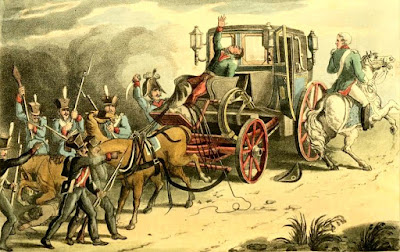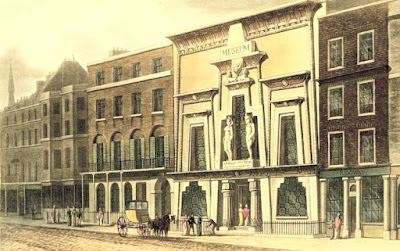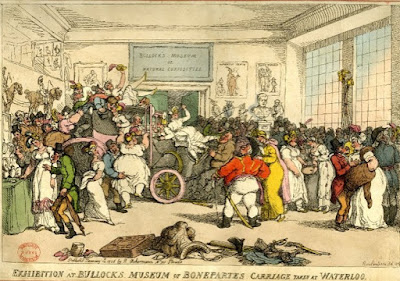 |
| The capture of Napoleon's carriage after the Battle of Waterloo from Ackermann's Repository (1816) |
How Napoleon’s carriage came to London
Napoleon’s carriage was captured by Major Von Keller at Genappe on the night of 18 June 1815 as Napoleon fled the battlefield of Waterloo. The Prussian Major “reserved the carriage as his own booty” and “brought it to England to gratify the curiosity of the people of this country, who have now an opportunity of viewing it at the London Museum, Piccadilly.”1
It is not clear whether the carriage was sold to the British government by the Prussians or sent as a present to the Prince Regent.
According to the Literary Panorama (1815):
The splendid carriage taken at the battle of Waterloo which was fitted up in a most magnificent style, for Buonaparte, was taken while waiting for the Ex-Emperor: the driver was killed by a Prussian general and Major. It was sent as a present to the Prince Regent, with the four horses which were attached to it, and a French driver accompanied it.2
However, the Monthly Magazine (1816) said:
It was taken by the Prussians, sold to Government, and re-sold,—lent to Mr Bullock as a Prussian trophy. Mr Bullock’s room constantly filled with company, and at least a hundred thousand persons have already gratified themselves by sitting in the very chariot which once held Napoleon le Grand.3
 |
| Mr Bullock's London Museum, Piccadilly from Ackermann's Repository (1815) |
Either way, the carriage came to England and was sold (or lent) to Mr Bullock. It went on display at his London Museum, at the Egyptian Hall, Piccadilly, and then, at the Prince Regent’s desire, went on tour throughout England, Scotland and Ireland. The carriage excited a good deal of interest and it was estimated that Mr Bullock made in excess of £26,000 from the exhibition!
The popularity of the exhibition at Bullock’s Museum was caricatured in Rowlandson’s print, shown below.
 |
| Exhibition at Bullocks Museum of Bonepartes Carriage taken at Waterloo by Thomas Rowlandson, published by R Ackermann (1816) © The Trustees of the British Museum |
What was the carriage like?
There was a detailed description of the carriage included with the print shown at the top of this post which appeared in Ackermann’s Repository (1816):
The exterior
The exterior of the carriage is, in many respects, very like the modern English travelling chariots. The colour is a dark blue, with a handsome bordure ornament in gold; but the Imperial arms are emblazoned on the pannels of the doors. It has a lamp at each corner of the roof, and there is one lamp fixed at the back which can throw a strong light into the interior.1It claimed that “the pannels of the carriage are bullet-proof” and stated that “the under-carriage and wheels are painted in vermillion, edged with the colour of the body, and heightened with gold.”
On the outside of the front windows is a roller-blind made of strong painted canvass: when pulled down, this will exclude rain and snow, and therefore secure the windows and blinds from being blocked up, as well as prevent the damp from penetrating.1
The interior
The interior deserves particular attention; for it is adapted to the various purposes of a kitchen, a bed-room, a dressing-room, an office, and an eating-room.
Among the gold articles are a tea-pot, coffee-pot, sugar-bason, cream-ewer, coffee-cup and saucer, slop-bason, candle-sticks, wash-hand-bason, plates for breakfast, &c. Each article is superbly embossed with the Imperial arms, and engraved with his favourite N.; and by the aid of the lamp, any thing could be heated in the carriage.
Beneath the coachman’s seat is a small box about two feet and a half long, and about four inches square; this contains a bedstead of polished steel, which could be fitted up within one or two minutes.
Other items in the carriage included “a small mahogany case” containing “the peculiar necessaire of the ex-emperor” - “nearly one hundred articles, almost all of them solid gold”; a liquor-case; and a writing desk.
Exhibited at Madame Tussaud’s
After the tour, the carriage and its contents were sold by auction and bought by someone who wanted to exhibit them in America. Unable to realise his intentions, it was sold again and then taken by a coach maker as part payment of a bad debt! In 1842, this company sold it to Madame Tussaud and Sons where it formed part of a special exhibition about Napoleon.
An advertisement in The Times (1843) stated:
Napoleon’s celebrated military carriage, taken at Waterloo, room magnificently fitted to show the decorations of his period, engravings of his history, splendid bust by Canova, the cloak he wore at Marenge, the sword of Egypt, the standard given to his guards, his watch, gold snuff box, ring, one of this teeth, the instrument that drew it, tooth-brush, Madras worn in exile, dessert service used by him at St Helens, counterpane stained with his blood: the greater part late the property of Prince Lucien – Madame Tussaud and Son’s Exhibition, Bazaar, Baker-Street: open from 11 till dusk, and from 7 till 10. Great room, 1s; Napoleon relics and chamber of horrors, 6d.4
 |
| Napoleon from The Life of Field-Marshal His Grace the Duke of Wellington by WH Maxwell (1852) |
The carriage was exhibited at Madame Tussaud's until 18 March 1925 when fire swept through the waxworks. A report in The Times declared that:
Madame Tussaud’s, the famous waxworks exhibition, which for generations has had a great fascination for visitors from every land, is no more.
Of the most treasured possessions of the exhibition, the Napoleonic relics, only scrap iron remains to suggest the coach in which the Emperor rode at Waterloo.
The owner, John Tussaud, commented that:
Fortunately, some of the items captured from Napoleon’s baggage train did survive and a number of them were on display at Windsor Castle in the Waterloo at Windsor 1815-2015 exhibition.
You cannot put a price on the Napoleonic relics…which cannot be replaced. I consider many of the most valuable things in the collection have been destroyed. They include Napoleon’s three coaches—the Waterloo coach, the carriage he used at St Helena, and the coach he is said to have used on the occasion of his coronation at Milan.5And so Napoleon’s carriage met a sad end, consumed by flames, 110 years after the Battle of Waterloo at which it was captured.
Fortunately, some of the items captured from Napoleon’s baggage train did survive and a number of them were on display at Windsor Castle in the Waterloo at Windsor 1815-2015 exhibition.
Notes
(1) From Ackermann’s Repository (Feb 1816).
(2) From Literary Panorama (Dec 1815) as quoted in The Military Carriage printed for Madame Tussaud and Sons (1843).
(3) From the Monthly Magazine (July 1816) as quoted in The Military Carriage printed for Madame Tussaud and Sons (1843).
(4) From The Times Digital Archive for 8 Apr 1843 accessed 6 Feb 2015 © Times Newspapers Ltd – transcribed by me.
(5) From The Times Digital Archive for 20 Mar 1925 accessed 6 Feb 2015 © Times Newspapers Ltd – transcribed by me.
Rachel Knowles writes clean/Christian Regency era romance and historical non-fiction. She has been sharing her research on this blog since 2011. Rachel lives in the beautiful Georgian seaside town of Weymouth, Dorset, on the south coast of England, with her husband, Andrew.
Find out more about Rachel's books and sign up for her newsletter here.If you have enjoyed this blog and want to encourage me and help me to keep making my research freely available, please buy me a virtual cup of coffee by clicking the button below.
Sources used include:
Ackermann’s Repository (1815-1816)
The Military Carriage of Napoleon Bonaparte, taken after the Battle of Waterloo, printed for Madame Tussaud and Sons (1843)
British Museum website
The Times Digital Archive


L'épée,le chapeau les décorations le manteau de Napoléon,etc,furent remis à Blücher à l'Auberge du roy d'Espagne ,Jacques Gilbert ,
ReplyDeletewww.aubergeduroydespagne.be
My French is not very good - I think this says that Napoleon's sword, hat, coat decorations - medals? were given to Blucher and there is a house called L'Auberge du roy d'Espagne - web address: www.aubergeduroydespagne.be
Delete